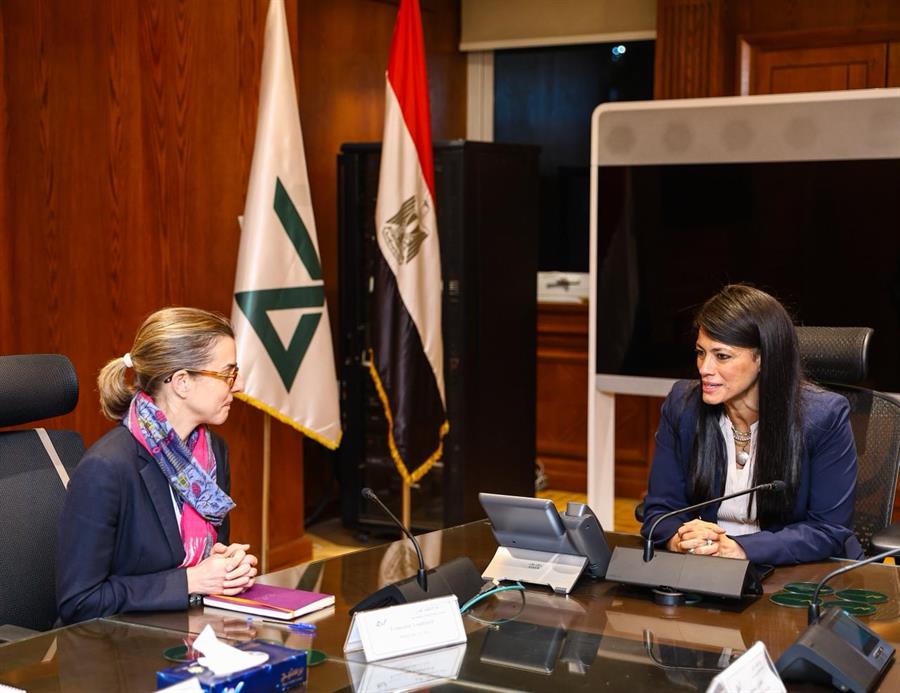Minister of Planning, Economic Development and International Cooperation Reviews Targets of the Economic and Social Development Plan for Fiscal Year 2025/2026 During the Meeting of the Senate's Committee on Financial and Economic Affairs
13 May 2025
Al-Mashat:
Continuation of applying governance to public investments during the next fiscal year to pave the way for private sector investments.
Improvement in economic growth driven by private investments and tradable and export-oriented sectors.
Allocation of 25 billion Egyptian pounds to commence the implementation of the second phase targets of the Presidential Initiative "Hayah Karima".
28 billion Egyptian pounds for local development investments and 24 billion Egyptian pounds for governorate investments in the next fiscal year's plan.
H.E. Dr. Rania A. Al-Mashat, Minister of Planning, Economic
Development and International Cooperation, reviewed the sectoral development
targets of the Economic and Social Development Plan for the fiscal year
2025/2026 during the meeting of the Senate's Committee on Financial and
Economic Affairs, chaired by Dr. Hani Sarie-El-Din, the committee's chairman,
and attended by the committee members, with the participation of a number of
heads of parliamentary bodies.
H.E. Dr. Al-Mashat highlighted the intellectual framework
and methodology for preparing the plan. She pointed to the new methodology for
setting the economic and social development plan for 2025/2026 according to a
comprehensive development perspective based on several pillars, including
Egypt's Vision 2030, the government's work program (2024/2025 – 2026/2027),
sectoral strategies and plans, the activation of the Public Planning Law No. 18
of 2022, the State Ownership Policy Document, the National Structural Reform
Program, and the Unified Public Finance Law No. (6) of 2022 (Medium-Term
Budgetary Framework).
Regarding the key directions of the fiscal year 2025/2026
plan, H.E. Dr. Al-Mashat pointed out that they include excluding new projects
that have not yet started implementation, taking into account the provision of
required investments for projects expected to be completed, divesting from
financing some projects while allowing private sector participation in
accordance with the State Ownership Policy Document for Assets, supporting food
security and energy security projects, in addition to supporting the
Presidential Initiative "Hayah Karima" projects, industrial
development and localization of industry projects, as well as focusing on
completion projects with high implementation rates, and stimulating innovation
and entrepreneurship.
H.E. Minister Al-Mashat highlighted the improvement in
economic activity in the second quarter of the fiscal year 2024/2025 – and the
continuation of the upward growth trend for the third consecutive quarter,
where indicators show continued signs of recovery. This momentum is expected to
continue, driven by private investments, with the economy shifting towards
tradable sectors, thanks to ongoing structural reforms and macroeconomic
stability. She clarified that the noticeable improvement in the performance of
the Egyptian economy recently came in light of the corrective fiscal and
monetary policies and the public investment governance efforts taken by the
government starting from March 2024.
H.E. Dr. Al-Mashat emphasized the continued increase in the
investment rate to reach 17.1% of GDP in fiscal year 2025/2026, compared to
lower rates in the previous two years (15% in 2024/2025 and 13% in 2023/2024),
which confirms the state's conviction in the important role that investment
plays as a fundamental driver of economic growth.
Regarding the evolution of the ratio of public and private
investment to total investments, H.E. Dr. Al-Mashat referred to the steady
increase in the proportion of private investments to total investments within
the framework of the state's direction towards governing investment spending
and setting specific ceilings for public investment, while giving priority to
completing ongoing public projects. This affirms the state's orientation
towards stimulating private investments in accordance with the State Ownership
Policy Document and competitive neutrality.
H.E. Minister Al-Mashat noted the growth of total
investments targeted by the plan to nearly 3.1 trillion Egyptian pounds for the
first time, compared to the expected investments for fiscal year 2024/2025,
which amounted to about 2.2 trillion Egyptian pounds, and the actual
investments for fiscal year 2023/2024, which amounted to 1.6 trillion Egyptian
pounds.
Health Sector
During the committee meeting, H.E. Dr. Rania Al-Mashat
outlined the most important targets of the health sector in the 2025/2026 plan.
She affirmed that within the framework of focusing on completion projects where
the implementation rate has exceeded 70% with the aim of bringing them into
service and benefiting citizens, the completion of 68 projects is targeted,
including (41) hospitals with investments of about 3.7 billion Egyptian pounds.
Pre-University and Higher Education
H.E. Dr. Al-Mashat pointed to the most important targets of
the education sector in the 2025/2026 plan. In the pre-university education
sector, the target is to establish 17,252 new classrooms, develop and
rehabilitate 1,851 existing schools, and replace and renovate 12,511
classrooms.
Regarding technical education, the target is to establish
536 new classrooms, replace and renovate 902 classrooms, and develop and
rehabilitate 126 existing schools, noting the reduction of classroom density to
40 students/classroom in 2024/2025, with a target of reaching 30
students/classroom by 2030.
At the level of the higher education sector in the 2025/2026
plan, the targets include the completion of educational building projects,
university cities, and civil defense in 28 public universities, in addition to
expansions of workshops and laboratories for 12 technological universities.
National Indicators for the Development of the Egyptian
Family
H.E. Dr. Al-Mashat mentioned the continued implementation of
the national project for the development of the Egyptian family within the
framework of human development and building the human being.
For the first time, the population issue is being addressed
according to a comprehensive development perspective, where the overall
strategic goal of the project is to improve the quality of life of citizens by
controlling population growth and improving population characteristics.
The most important outputs of the national project for the
development of the Egyptian family include the Ministry allocating about 2
billion Egyptian pounds for the implementation of the project in cooperation
with implementing agencies and partners. The total number of beneficiaries of
the project's services reached about 28 million citizens (90% females and 10%
males) by October 2024. The percentage of beneficiaries from the cultural and
awareness intervention axis reached 66%, and about 31.5% benefited from the
interventions of the economic empowerment axis. This is in addition to the
pilot operation of 10 family development centers and the receipt of 3 other
centers out of a target of 52 family development centers that provide family
health services, childcare, and maternal care, and the establishment and
development of 1,641 nursery classrooms, exceeding the target of 1,000
classrooms.
H.E. Minister Al-Mashat noted a significant improvement in
demographic indicators, including recording the lowest population growth rate
in Egypt during the first quarter of 2025 at 1.34%, compared to about 1.4% in
the corresponding quarter of 2024 and 1.6% in the same quarter of 2023.
Electricity and Renewable Energy Sector
H.E. Minister Al-Mashat pointed out the targets of the
electricity and renewable energy sector in the 2025/2026 plan. The most
important targeted projects include completing the electricity supply for
agricultural reclamation projects (New Delta, Sinai, South Valley in Toshka,
Beni Suef and Minya, Sanabel Sono), completing the electricity supply for the
East Oweinat and Toshka areas, in addition to completing the electricity supply
for the high-speed electric train project (Ain Sokhna – Marsa Matrouh), and the
electricity supply for the third phase connection project of the Light Rail
Transit (LRT) and the connection project of the first phase transformer station
of the Fourth Metro Line.
H.E. Dr. Al-Mashat pointed to the targets of the housing,
utilities, and urban communities sector in the 2025/2026 plan, which include
the completion of (121) water station projects with a capacity of 3.8 million
cubic meters/day at a cost of 2.5 billion Egyptian pounds, with the completion
of (56) projects expected; the completion of (351) sanitation projects (cities
+ villages) at a cost of 5.1 billion Egyptian pounds, with the completion of
(135) projects expected; and the completion of (17) desalination plant projects
with a capacity of 455 thousand cubic meters/day at a cost of 2.8 billion
Egyptian pounds, with the completion of (8) projects expected; in addition to
the completion of (94) treatment plant projects with a capacity of 12.3 million
cubic meters/day at a cost of 5.3 billion Egyptian pounds, with the completion
of (33) projects expected.
Industry Sector
Regarding the targets of the industry sector in the
2025/2026 plan, H.E. Dr. Al-Mashat mentioned that they include completing the
work of raising the efficiency and expansion of the industrial wastewater
treatment plant in the Leather City in Al-Rubiki (from a capacity of 8,000
cubic meters/day to 24,000 cubic meters/day), increasing the capacity of the
industrial wastewater treatment plant from 24,000 cubic meters/day to 36,000
cubic meters/day, including water works, as well as completing the development
works in Upper Egypt in the governorates of Qena and Sohag to complete raising
the efficiency of the infrastructure in the industrial zones in Upper Egypt
(Qena and Sohag) in cooperation with the Ministry of Local Development.
Transportation Sector
Regarding the targets of the transportation sector in the
2025/2026 plan, H.E. Dr. Al-Mashat pointed out that there are 24 projects
targeted for completion in the roads and bridges sector, including (5) projects
in the national and strategic road network and (13) projects in the roads
connecting governorates. In addition, there are 38 projects targeted for
completion in the roads and bridges sector, including (6) projects in the
national and strategic road network.
H.E. Minister Al-Mashat reviewed the targets for empowering
local administration and enhancing the trend towards decentralization, where
the plan aims to direct investments of 28 billion Egyptian pounds for local
development, and governorate investments amount to 24.3 billion Egyptian pounds,
noting the continued implementation of the performance excellence incentives
initiative in public investment management at the local level.
H.E. Dr. Al-Mashat affirmed that the transition towards a
green economy and consideration of environmental sustainability represents a
major direction in the state's development efforts.
Within the framework of attention to greening public
investments, Egypt's Vision 2030 adopts the principle of "achieving
sustainability" and the transition towards a green economy. It is targeted
that the proportion of green public investments out of total public investments
will reach 55% during the 2025/2026 plan.
H.E. Dr. Al-Mashat confirmed that 25 billion Egyptian pounds
have been allocated to start implementing the targets of the second phase of
"Hayah Karima" in the fields of drinking water and sanitation. The
target is to implement 698 integrated sanitation projects, in addition to
extending and reinforcing 2,350 km of drinking water networks, and 18 targeted
drinking water stations.









